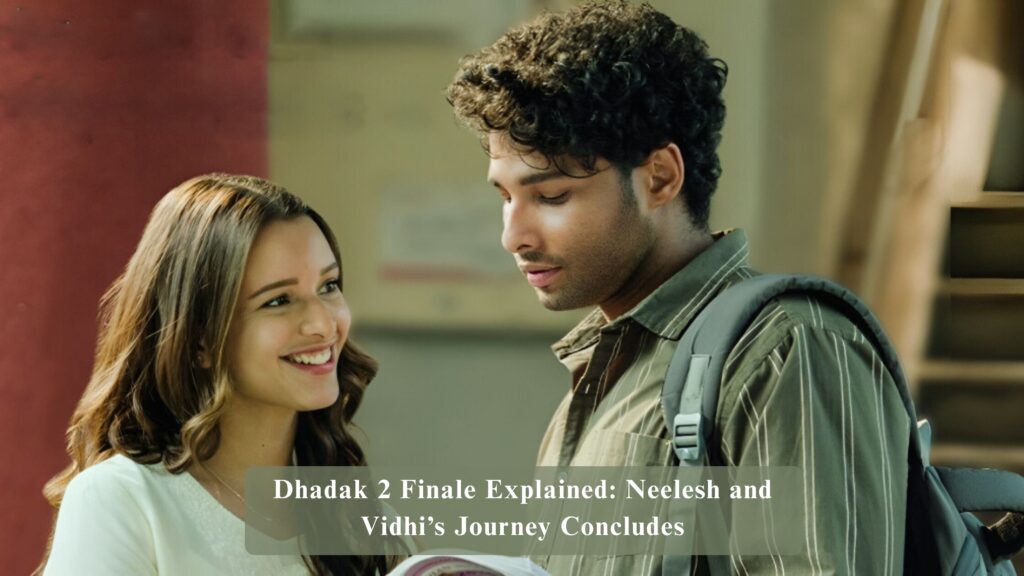When I watched Dhadak 2, I didn’t expect it to stay with me long after the credits rolled. I knew it was a love story layered with social tension, but I didn’t anticipate how deeply it would dig into questions of dignity, identity, and survival. As I sat there in the dimly lit theater, watching Dhadak 2 Ending Explained Neelesh and Vidhi’s story unfold, I felt like I wasn’t just observing a film—I was witnessing fragments of reality stitched into fiction.
Dhadak 2 Ending Explained, in particular, left me reflective and unsettled, not because it was tragic, but because it was defiantly hopeful in a world that rarely allows such hope. In this piece, I want to unpack everything I felt and saw in those final moments, but to get there, we need to walk back through the journey of Neelesh and Vidhi—their love, their trials, and the emotional storm that builds to one of the most striking endings I’ve seen in recent cinema.
A Love Born in Silence and Tenderness
In Dhadak 2 Ending Explained From the very first moments, Neelesh’s character is drawn with quiet precision. He isn’t flashy, loud, or overtly charismatic. Instead, he embodies restraint—the kind of restraint learned from a life where attention is dangerous, where dignity is often taken rather than freely given. As a young man from a marginalized background, he has grown used to existing in the spaces between things: studying quietly, observing others, and carrying himself with a calm that almost feels like armor.
Vidhi, on the other hand, steps into the frame like sunlight. She’s gentle and lively, someone who has known comfort but isn’t hardened by it. Their first interactions are subtle: small exchanges in a classroom, shared smiles that linger just a little too long, conversations that seem mundane but glow with warmth beneath their simplicity. It’s not love-at-first-sight in the grand, dramatic sense, but rather a slow weaving together of two lives.
What struck me most in the early parts of the film is how ordinary their love feels. It’s not built on grand gestures or cinematic fireworks—it’s built on late-night study sessions, jokes about shared teachers, and quiet walks back from campus. In that ordinariness lies its beauty. For a while, you almost forget the world outside them.
The First Fractures
Reality intrudes in subtle ways at first. Neelesh hesitates to visit Vidhi’s home. He often sidesteps personal questions about his family, his background. Vidhi notices, but she doesn’t push. She believes, perhaps naively, that love alone will be enough to dissolve those silences.
Then comes the wedding. Vidhi invites Neelesh, and it feels like a natural step forward—until it isn’t. The moment Neelesh enters her family’s world, everything shifts. The atmosphere sharpens; polite smiles turn brittle. A cousin, Ronnie, mocks him with thinly veiled contempt. A few whispered slurs cut deeper than any outright insult could. Vidhi, caught between wanting to shield Neelesh and wanting to avoid conflict with her family, brushes it aside, but Neelesh can’t.
The violence comes suddenly, brutally. After a heated argument, Neelesh is ambushed and beaten by Ronnie and his friends. The scene isn’t stylized; it’s raw and messy. Dhadak 2 Ending Explained Watching it, I felt my stomach clench—not just at the violence itself, but at Neelesh’s silence afterwards. He doesn’t retaliate, doesn’t even tell Vidhi the full truth. He simply withdraws, wounded in body and spirit.
The Weight of Quiet Rage

This is where the film begins to dig deeper. Neelesh’s withdrawal isn’t just about fear—it’s about internalized exhaustion. He has spent his life navigating a world that demands he stay in his place, and this beating is just another reminder of that boundary.
Vidhi notices his distance, and their relationship begins to strain. Her world, despite her affection for him, doesn’t fully grasp his. The film doesn’t villainize her for this ignorance—it paints her as someone trapped in the bubble of her upbringing, desperately trying to reach beyond it but not yet fully seeing what lies on the other side.
At the same time, we see Neelesh’s slow simmer. He’s encouraged by Principal Haider Ansari, who recognizes his potential and urges him to stand up not just for himself but for what he represents. Yet Neelesh resists. His line—“I am tired of fighting battles I never chose”—echoed in my head long after.
The Shadow of Violence: Shankar’s Arrival
Just when it feels like things couldn’t escalate further, Vidhi’s uncle brings in Shankar—a man whose cold efficiency is chilling. He’s not just a hired thug; he’s someone who believes in what he’s doing. To him, killing Neelesh isn’t murder—it’s “restoring order.”
This is where Dhadak 2 Ending Explained digs into its darkest themes. Shankar is a walking reminder of how violence often dresses itself up as tradition. His presence looms over every scene he’s in, and it’s terrifying because he’s not chaotic; he’s methodical, almost ritualistic.
When Shankar kidnaps Neelesh and ties him to the railway track, it’s a gut-wrenching moment. The symbolism is heavy: Neelesh, literally bound to the very rails society has fixed for him, staring at an oncoming train he cannot escape.
Neelesh’s Transformation
This is where everything pivots. In those final minutes before impact, Neelesh remembers his late dog Kaalu, who had been killed on similar tracks. He remembers his mother’s voice urging him to fight. And something changes.
In Dhadak 2 Ending Explained a surge of determination, he frees himself and escapes just in time. It’s not shot like a heroic escape—it’s frantic, desperate, and entirely human. You can feel his breath, his trembling hands. This isn’t the moment of a cinematic superhero—it’s the moment of an ordinary man deciding he will not be erased.
The Confrontation with Shankar
Freed, Neelesh faces Shankar. Their fight is brutal and grounded. There’s no choreographed elegance—just two bodies colliding, fists fueled by desperation. When Neelesh finally gains the upper hand, he spares Shankar’s life, walking away battered but alive.
But Shankar, bound by his twisted sense of “honor,” cannot live with failure. In a haunting moment, he steps onto the same tracks meant for Neelesh and ends his life. It’s both disturbing and symbolic: a man consumed by an ideology dies by the very violence he worshipped.
Truth and Reckoning
From here, Neelesh goes straight to Vidhi’s family. This isn’t revenge—it’s reclamation. He stands before them, bruised but unbroken, and speaks with quiet authority. He tells them he knows everything. He forgives them—not out of weakness, but as a weapon of truth: “If Vidhi ever learns what you’ve done, she will never forgive you. And you will live with that.”
It’s such a striking moment because it’s not about shouting or rage. It’s about calm, measured words that carry more weight than any blow could.
Vidhi overhears enough to piece together the truth. Her reaction is explosive. She screams at her father, denounces their actions, and—without hesitation—chooses Neelesh. It’s messy and emotional, and it feels real.
The Closing Image: Choosing Each Other
Dhadak 2 Ending Explained: The final sequence is beautifully understated. Neelesh and Vidhi are seen sitting together on a bus, holding hands. There are no grand declarations, no overblown musical cues. Just two people, battered by the world, choosing each other in spite of it.
This isn’t a fairy tale. Their future is uncertain. Society hasn’t changed overnight. But they’ve survived. And in survival, there’s defiance.
Why This Ending Resonates
What makes this Dhadak 2 Ending Explained powerful is that it doesn’t romanticize their pain or erase it with an unrealistically perfect solution. Instead, it gives us a quiet victory—a promise that love and dignity can endure, even when they don’t erase the world’s cruelty.
Neelesh doesn’t become a hero in the traditional sense. He becomes something rarer: a man who refuses to break, who claims his own worth in a world determined to deny it. Vidhi’s arc, too, is one of awakening—not saviorhood, but solidarity.
Final Reflections
Leaving the theater, I didn’t feel triumphant. I felt heavy but hopeful. Dhadak 2 doesn’t give us a world transformed; it gives us two people who decide to live and love in spite of everything stacked against them. And sometimes, that is more radical than any sweeping change.
The ending worked because it felt honest. It’s not the ending of a love story alone—it’s the ending of a fight for selfhood, the kind fought quietly in classrooms, at dinner tables, on railway tracks.
Dhadak 2 Ending Explained Neelesh and Vidhi’s journey reminded me that love stories don’t need grand weddings or perfect reconciliations to matter. Sometimes, two people surviving together is the boldest ending of all.
Explore more in-depth marvel movie discussions and analyses here….




